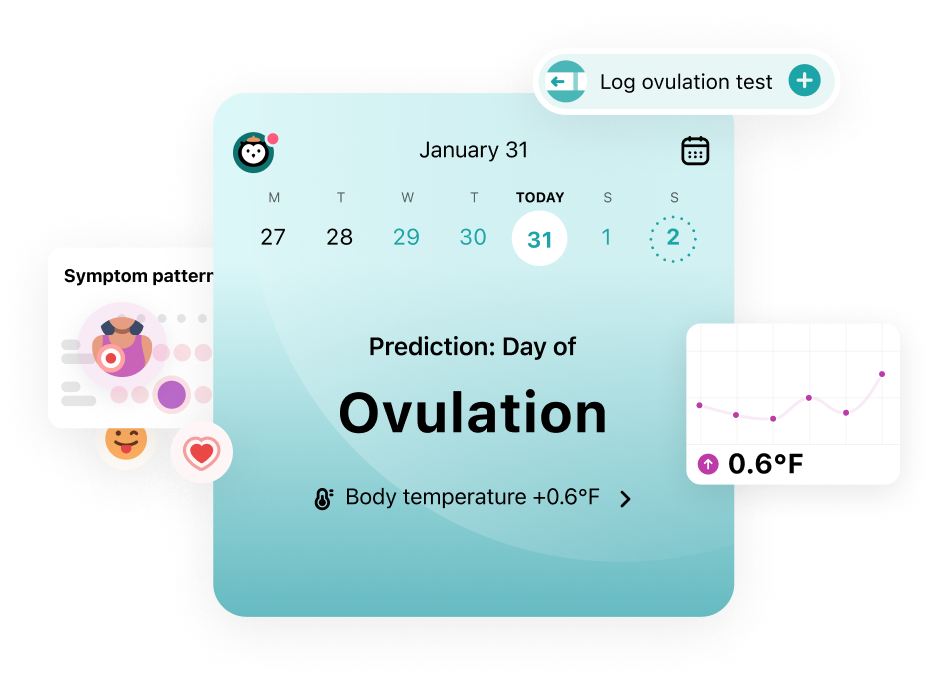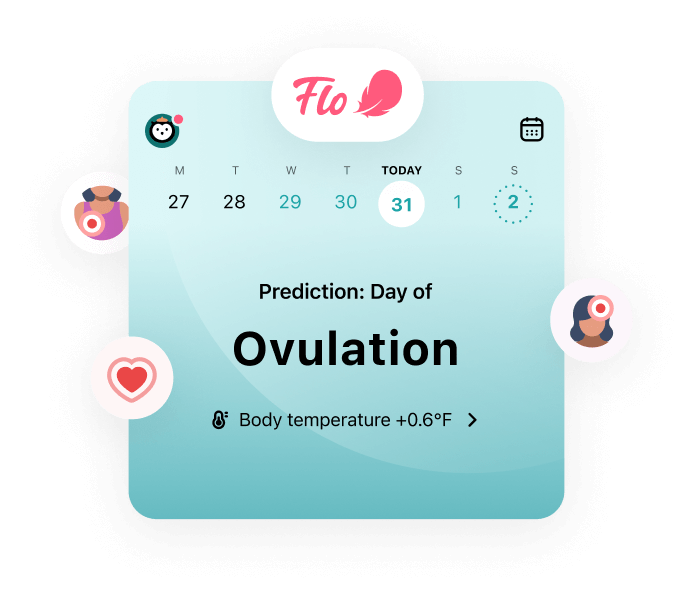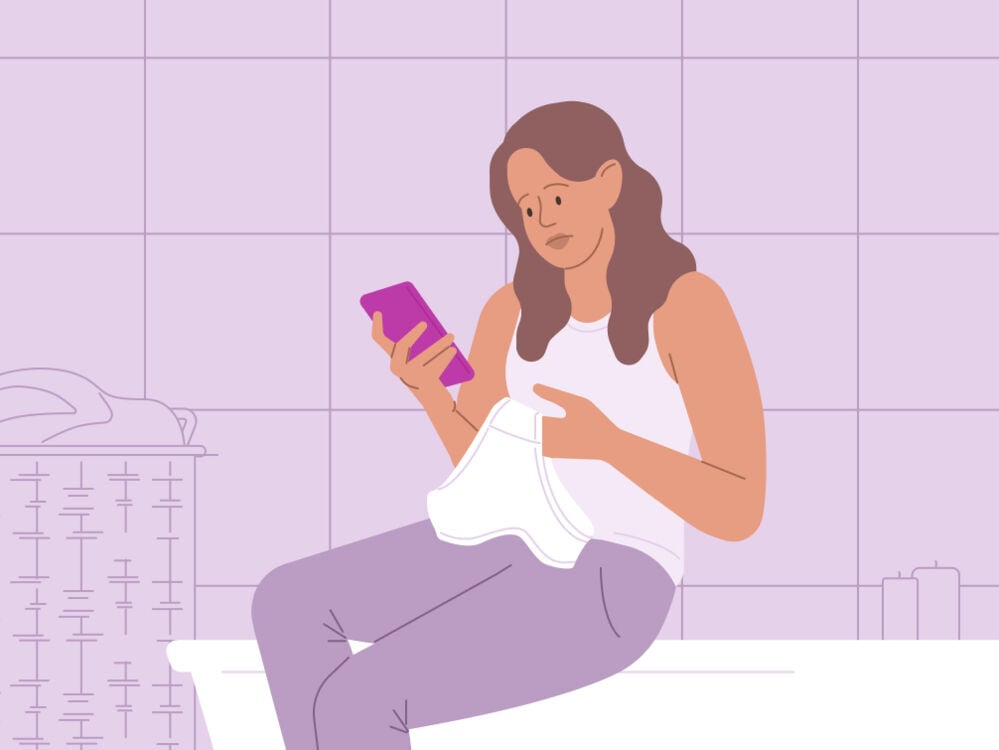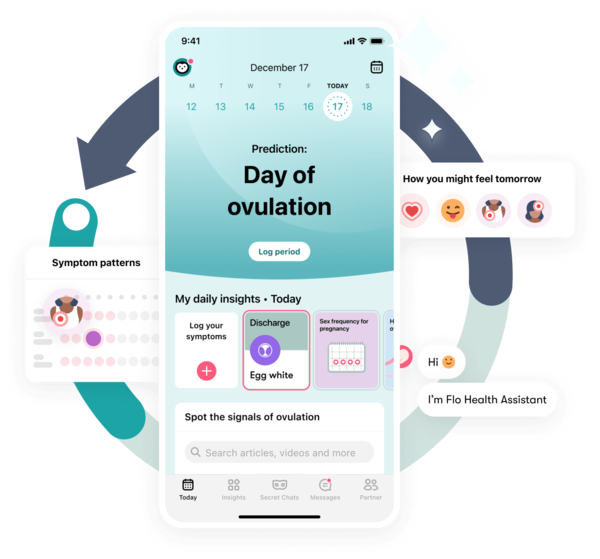Find out how to track ovulation and give yourself the best chance of getting pregnant with advice from a Flo expert.
-
Tracking cycle
-
Getting pregnant
-
Pregnancy
-
Help Center
-
Flo for Partners
-
Anonymous Mode
-
Flo app reviews
-
Flo Premium New
-
Secret Chats New
-
Symptom Checker New
-
Your cycle
-
Health 360°
-
Getting pregnant
-
Pregnancy
-
Being a mom
-
LGBTQ+
-
Quizzes
-
Ovulation calculator
-
hCG calculator
-
Pregnancy test calculator
-
Menstrual cycle calculator
-
Period calculator
-
Implantation calculator
-
Pregnancy weeks to months calculator
-
Pregnancy due date calculator
-
IVF and FET due date calculator
-
Due date calculator by ultrasound
-
Medical Affairs
-
Science & Research
-
Pass It On Project New
-
Privacy Portal
-
Press Center
-
Flo Accuracy
-
Careers
-
Contact Us
How to track ovulation: 5 ways to figure out when you’re most fertile


Every piece of content at Flo Health adheres to the highest editorial standards for language, style, and medical accuracy. To learn what we do to deliver the best health and lifestyle insights to you, check out our content review principles.
Trying for a baby can be an exciting and anxious time all at once. Once you’ve decided that you’d like to start a family, it’s natural to want to do all you can to maximize your chances of conceiving.
You may have heard about your fertile window. Basically, this is the point in your cycle when you’re most likely to get pregnant. It’s true that having lots of sex around ovulation can boost your chances of getting pregnant. But how can you tell when you’re ovulating? These five simple methods can help you figure out when your fertile window is likely to be.
Key takeaways
- Your fertile window lasts for an average of six days each cycle, including the five days before ovulation plus the day after.
- If you have a 28-day cycle (which is considered to be average), ovulation happens midway through your cycle on day 14. However, as normal cycles can range from 21 to 35 days long, the timing of when you ovulate can also vary from month to month, and it can be hard to pinpoint the exact day.
- There are several methods to help you predict when you’ll ovulate, from analyzing your menstrual cycle and discharge to investing in tests and smart devices. You can also look for the signs and symptoms of ovulation. The best method — or combination of methods — comes down to personal preference and what suits you.

 Over
7.8M
ratings averaging
4.8/5
*
Over
7.8M
ratings averaging
4.8/5
*
Understand your fertility better with the Flo app
- Learn more about your fertility signals
- Improve ovulation predictions by tracking temperature via Apple Watch
- Log your ovulation test results
 Over
7.8M
ratings averaging
4.8/5
*
Over
7.8M
ratings averaging
4.8/5
*

Trying to conceive?
The Flo app can help you better understand your fertility

 Over
7.8M
ratings averaging
4.8/5
*
Over
7.8M
ratings averaging
4.8/5
*
Understand your fertility better with the Flo app
- Learn more about your fertility signals
- Improve ovulation predictions by tracking temperature via Apple Watch
- Log your ovulation test results
Ovulation is when your body releases an egg in the hope that it will be fertilized by a sperm. It’s when you’re most fertile during your cycle and usually happens around the midpoint. That means that if your cycle is around 28 days, then this happens at approximately day 14.
Once an egg has been released from one of your ovaries, it travels down one of your uterine tubes. For the next 12 to 24 hours, it’s what doctors call “viable” or able to be fertilized. If you have sex during this time, a sperm might meet your egg in the tube and fertilize it. This is the part known as conception. If this happens, then your fertilized egg may travel down to your uterus and attach to the lining of the uterus — a process known as implantation. If this happens, then you’re officially pregnant.
The 12-to-24-hour window, when your egg is still viable, might seem like a really short period. But your fertile window is actually much longer than that. This is because sperm can live in your body for up to five days. That means your fertile window spans around six days in total: the five days before ovulation plus one day after.
How to track ovulation
If you’re trying to get pregnant, then the best place to start is to figure out when you’re likely to ovulate. This can vary from cycle to cycle and person to person. All this means is that knowing exactly when you’ll ovulate can be tricky. Using one or a combination of the following methods can help you spot the patterns and pinpoint when ovulation is most likely to happen for you.
1. Try the calendar method
Up for a bit of math? The calendar method (sometimes called the rhythm method) calculates the length of your previous menstrual cycles to figure out which days could include your fertile window.
“For those who have a predictable menstrual cycle, the calendar method can be a very reliable way to track ovulation,” says Dr. Renita White, obstetrician and gynecologist, Georgia Obstetrics and Gynecology, Georgia, US. “Predictable cycles mean that you can determine when your next period will be each month.”
The method involves following these simple steps:
- Record the length of six to 12 menstrual cycles. This means counting the days between the first day of one period and the first day of your next period.
- Write down the lengths of your shortest menstrual cycle and your longest cycle.
- Subtract 18 from the total number of days in your shortest cycle. This number represents your first fertile day. For example, if your shortest cycle is 28 days long, your first fertile day would be day 10.
- Subtract 11 from the total number of days in your longest menstrual cycle. This number represents the last fertile day. For example, if your longest cycle is 34 days long, your last fertile day would be day 23. If you’re trying for a baby, it may be the best time to schedule some conception sex during your possible fertile days, which in the example above would be between days 10 and 23.
- Keep updating your calculations each month — the more up to date you are, the better.
You might have also heard of the calendar method called the standard days method. This is incredibly similar with a slight variation and works best if your cycles are usually between 26 and 32 days long. The idea is that if your cycles are always this regular, your fertile days should land between days eight and 19.
As many factors can impact the timing of ovulation, from illness to stress, these methods of tracking ovulation aren’t always accurate — especially if you have irregular periods. However, they can be a great place to start and are totally free.

2. Use a cycle-tracking app
If your head is in a spin from all that counting, a menstrual cycle and ovulation-tracking app like Flo can do the math for you. Apps like Flo work in a similar way to the calendar method. But all you need to do is log your period dates for a couple of cycles, and an algorithm will predict your ovulation days for you.
“These tracking apps make it easy to look back and review patterns each month,” says Dr. White. “Not only can you see how often you get a period, but you can also see when you typically get certain symptoms such as bloating, cervical mucus, or premenstrual syndrome. This can make it easier to identify your ovulation window.”
With Flo, you can easily log these symptoms and learn more about why they happen, so you’ll become a pro at spotting your likely fertile window in no time! You can also log your basal body temperature (BBT) and ovulation test results, keeping all that important information in one place. Try Flo for free now.
3. Get an ovulation predictor kit
Ovulation predictor kits can take the guesswork out of tracking ovulation by confirming when you’re about to release an egg. If you use them correctly, these tests can be up to 99% accurate. For some people, this level of certainty can help reduce the anxiety around trying for a baby, while others may find it adds to the pressure. Everyone is different, and it’s about finding what feels right for you.
So, how do ovulation kits work? Well, the tests look for luteinizing hormone (LH), which is the hormone that makes your ovaries release an egg. LH surges 24 to 48 hours before you ovulate — so by detecting this surge, ovulation tests can tell you when it might be best to have conception sex. “Some tests also detect estrogen levels, which also increase around ovulation with the goal of being more accurate,” adds Dr. White.
Like home pregnancy tests, ovulation kits involve peeing on a stick to measure your hormone levels. To pick up the LH surge, you might need to keep testing for several days (the packs usually come with around five to seven sticks). As a general rule, you should start testing three to five days before you think you might ovulate.
4. Track your basal body temperature
Did you know that ovulation can make you slightly warmer? Basal body temperature (BBT) is your temperature when your body is completely at rest. When you ovulate, your BBT increases by 0.4º F (0.22º C) to 1º F (0.56º C). So, measuring your BBT every day — using a special thermometer with two decimal places — can help you learn when you tend to ovulate. “To best use this technique, it’s ideal to track your temperature for a few months to determine the typical time your basal body temperature increases,” says Dr. White.
For the most accurate readings, you should:
- Take your temperature as soon as you wake up, around the same time each day, and before you get out of bed.
- Make sure you have had at least three hours of uninterrupted sleep before taking a reading.
- Make a note of when you’ve had a fever or been unwell, drunk alcohol, been stressed, had a bad night’s sleep, have overslept, or have traveled in a different time zone. These factors can influence your BBT and make your readings less accurate.
Measuring your BBT with a thermometer each day can get fiddly and feel like a chore, especially if you’re not a morning person. Thankfully, you can now buy wearable devices with built-in sensors that will measure BBT for you. Often, these devices can pair with Flo, helping you bring all your cycle information together.
5. Keep an eye on your discharge
You certainly don’t need to invest in a wearable device to accurately predict ovulation. In fact, the answer could be in your underwear. That’s because just before you ovulate, your discharge (also known as cervical mucus) goes through some changes.
Throughout the first half of your cycle, the cervical mucus will be thick, white, and dry. Then, just before and during the day of ovulation, it will turn clear and slippery, a bit like raw egg whites. This is to help make it easier for sperm to swim through your reproductive tract and meet an egg. Clever, right?
The egg white discharge usually lasts for about four days, signaling that it’s time to have unprotected sex if you’re trying. After ovulation, your discharge will become dry until you get your period a couple of weeks later.
Take a quiz
Find out what you can do with our Health Assistant
“Though it is common for people to have these changes around ovulation, some people may have a hard time noticing the changes to the cervical mucus,” says Dr. White. “Others may have ovulation-type cervical discharge for longer periods of time. Being on certain medications like birth control can also affect what your cervical mucus looks like.”
A change in your cervical mucus isn’t the only possible sign of ovulation that you’ll notice. Some people experience symptoms of ovulation pain such as cramping, heightened sex drive, bloating during ovulation, mood changes, and light bleeding around the time of ovulation.
Keeping an eye out for the signs of ovulation and tracking them in an app like Flo can help you get to know the pattern of your most fertile days.
What’s the best method for tracking ovulation?
It can be hard to know which method of ovulation tracking is best for you. “The most accurate method is an ovulation kit since it detects the presence of hormones that spike before ovulation,” says Dr. White. However, while ovulation tests are up to 99% accurate when used correctly, they can be expensive, and some might find the testing process stressful.
Each method has its benefits and drawbacks. For example, the calendar method might suit some people best because it’s free — but it can be less useful for people who have irregular periods.
Ultimately, there’s no “best method” for tracking ovulation. The right one will be personal to you. The best thing you can do is try out a few different methods and see how you like them. And remember, whichever type you choose, an app like Flo for Getting Pregnant can help you keep track of your cycle dates and symptoms as you go.
More FAQs
How long after your period do you ovulate?
Ovulation happens midway through your cycle. That means in a standard 28-day cycle, it will take place around day 14. But, as a normal cycle can last anywhere from 21 to 35 days, exactly when this midway point happens will vary from person to person.
Can you only get pregnant during ovulation?
You can only get pregnant if you have unprotected sex during your fertile window, which includes the five days before and the day after ovulation. Remember: you should never use cycle tracking apps as birth control.
Why didn’t I get pregnant when tracking ovulation?
You have around a 20% chance of getting pregnant each cycle, even when tracking ovulation, so it’s actually very normal for it not to happen in one particular cycle.
Most couples will get pregnant after a year of trying. You have a 75% chance after six months, 90% after a year, and 95% after two years. If you’re worried about your fertility, your doctor is there to support you. So make sure you have a chat with them about any concerns you have.


Hey, I'm Anique
I started using Flo app to track my period and ovulation because we wanted to have a baby.


The Flo app helped me learn about my body and spot ovulation signs during our conception journey.


I vividly
remember the day
that we switched
Flo into
Pregnancy Mode — it was
such a special
moment.
Real stories, real results
Learn how the Flo app became an amazing cheerleader for us on our conception journey.
References
“Basal Body Temperature for Natural Family Planning.” Mayo Clinic, 10 Feb. 2023, www.mayoclinic.org/tests-procedures/basal-body-temperature/about/pac-20393026.
“Ovulation.” Cleveland Clinic, my.clevelandclinic.org/health/articles/23439-ovulation. Accessed 10 May 2024.
“Ovulation Home Test.” MedlinePlus, medlineplus.gov/ency/article/007062.htm. Accessed 10 May 2024.
Parenteau-Carreau, S., and C. Infante-Rivard. “Self-Palpation to Assess Cervical Changes in Relation to Mucus and Temperature.” International Journal of Fertility, vol. 33, suppl., 1988, pp. 10–16.
“Rhythm Method for Natural Family Planning.” Mayo Clinic, 7 Mar. 2023, www.mayoclinic.org/tests-procedures/rhythm-method/about/pac-20390918.
Settlage, D. S., et al. “Sperm Transport from the External Cervical Os to the Fallopian Tubes in Women: A Time and Quantitation Study.” Fertility and Sterility, vol. 24, no. 9, Sep. 1973, pp. 655–61, doi:10.1016/s0015-0282(16)39908-3.
“Should You Use Ovulation Strips to Get Pregnant?” Cleveland Clinic, 12 May 2021, health.clevelandclinic.org/should-you-use-ovulation-strips-to-get-pregnant.
“Sperm: How Long Do They Live after Ejaculation?” Mayo Clinic, 5 May 2022, www.mayoclinic.org/healthy-lifestyle/getting-pregnant/expert-answers/pregnancy/faq-20058504.
Steward, Kaitlyn, and Avais Raja. “Physiology, Ovulation and Basal Body Temperature.” StatPearls Publishing, StatPearls Publishing, 2023, https://www.ncbi.nlm.nih.gov/books/NBK546686/.
Suarez, S. S., and A. A. Pacey. “Sperm Transport in the Female Reproductive Tract.” Human Reproduction Update, vol. 12, no. 1, Jan.-Feb. 2006, pp. 23–37, https://doi.org/10.1093/humupd/dmi047.
Taylor, Alison. “ABC of Subfertility: Extent of the Problem.” BMJ, vol. 327, no. 7412, 23 Aug. 2003, pp. 434–36, doi: 10.1136/bmj.327.7412.434.
Witt, Barry. “Trying to Get Pregnant? Here’s When to Have Sex.” The American College of Obstetricians and Gynecologists, Aug. 2023, www.acog.org/womens-health/experts-and-stories/the-latest/trying-to-get-pregnant-heres-when-to-have-sex.
Wilcox, A. J., et al. “The Timing of the ‘Fertile Window’ in the Menstrual Cycle: Day Specific Estimates from a Prospective Study.” BMJ, vol. 321, no. 7271, 18 Nov. 2000, pp. 1259–62, https://doi.org/10.1136/bmj.321.7271.1259.
History of updates
Current version (13 May 2024)
Published (13 May 2024)
In this article

Get your personal guide to fertility
-
Learn how to read your body's ovulation signals
-
Find daily conception tips from our experts
-
Chat with others who are trying to get pregnant




